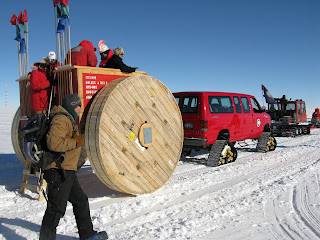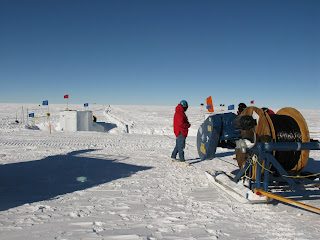This is looking back towards the station from the road back from the IceCube Lab (ICL). You can see how the snow drifts up in front of the station.

The ICL. The two towers on either side contain the cables coming back from the IceCube array. They left a tens of meters of extra cable to allow the array to be used for a long time as the snow drifts around and up the building. In a couple decades or so the first floor may be partially covered by the drifting snow and eventually the second floor will be the main entrance.

Static electricity is a major problem at the South Pole. Sensitive electronics have been destroyed by someone taking off their big red 5 feet from the components. The relative humidity in a lot of the buildings is in the single digits, but interestingly enough the relative humidity outside is around 80%. However, because the air is so cold, you heat up the pocket of air around your skin and the relative humidity drops. The high relative humidity outside governs and is a result of the rate of sublimation of the ice. I don't quite know how to get a photo of it, but when I move my hand across the comforter when getting into bed at night, you can see dozens of blue flashes. The ICL takes static discharges pretty seriously, and you can tell by the copper grounding strips found throughout the building. It seems to me that it's a little overboard.

This shot is looking back towards the station from the roof of the ICL.

A view of the drill camp from the roof of the ICL. You may notice the chariot and the purple palace which is where I do some other work.

A view of the drill camp with the purple palace in the middle of the shot.


Here you can see the South Pole Telescope and MAPO from the drill camp.

The van is parked in front of the MAPO building. The Spirex telescope is attached to it on the right. In the background you can see the South Pole Telescope. IceCube, MAPO, and the South Pole Telescope make up the major experiments in the Dark Sector.

Here's a photo of MAPO from the roof of the ICL. On the left is Viper and on the right is Spirex.

During my quest for screws, I thought this building was MAPO, but it turns out it was AST/RO which has been buried to the point that the second floor is now the first floor. They were in the process of demolishing the inside which was my first clue that it was not what I was looking for.

This is looking back towards the IceCube area from the MAPO building that had some screws that we needed.

The work I do day-to-day is variable, but on Friday I spent a good portion of the day under the ICL connecting and disconnecting different components so we could calibrate our instrument. The challenge of the day was keeping the noise source warm while it was directly hooked up to the cold instrument we were calibrating. Apparently we weren't too successful, so we will try again today or tomorrow. In this photo you can see where I spent my afternoon. The board was there to try to keep the components in the shade to keep them cold.





















































